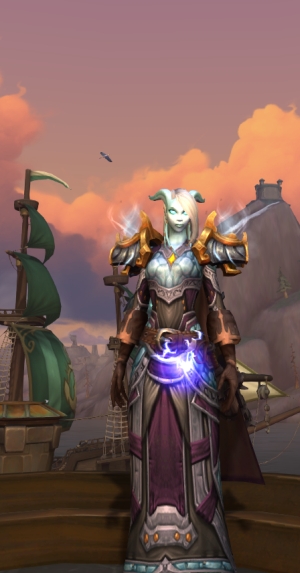
You know that old chestnut about how the greatest trick the devil ever pulled was convincing the world he didn’t exist? The greatest trick Guild Wars 2 ever pulled was convincing people that it never raised its level cap.
Before you go back and double-check, yes, I’m making a point here. That statement is, at face value, completely accurate. The level cap was 80 when it launched, and it remains 80 now in the game’s second expansion, and it’ll probably be 80 in a decade when we’re on the third expansion. (I jest.) Numerically, the level cap has remained fixed.
The thing is, though, that there are still just as definitely endgame areas and higher-level areas, and the game’s universal and ubiquitous level scaling doesn’t change that fact. So let’s talk a bit about relevance, what it means, and how something isn’t relevant just because you can’t out-level it. You know, light and simple stuff for the day after a holiday.
 Unlike “meaningful,” relevant isn’t a word that has gotten marketing forces to do a tap-dance on its grave repeatedly, even though in many ways it’s far more important. While we laid out criteria for something to be actually meaningful, we don’t need to hit three points for relevance. Something is relevant if it contributes at a reasonable rate to your overall goals in the game.
Unlike “meaningful,” relevant isn’t a word that has gotten marketing forces to do a tap-dance on its grave repeatedly, even though in many ways it’s far more important. While we laid out criteria for something to be actually meaningful, we don’t need to hit three points for relevance. Something is relevant if it contributes at a reasonable rate to your overall goals in the game.
To use a classic example from World of Warcraft, spending half an hour doing a dungeon has a chance of getting you loot, will definitely get you money, will earn you experience, and has a chance at some other rewards. Spending half an hour dancing on a mailbox has, at best, a very low chance of someone tossing you some coins. You wouldn’t talk about the latter as relevant content; it’s not something you engage with for any reason other than your own momentary amusement.
That’s actually important to consider. Things can be fun without necessarily being relevant. Heck, sometimes they’re just things you want to do with full knowledge that they’re not going to be particularly relevant. If I spend a bunch of time going through a dungeon in Final Fantasy XIV as a roleplaying expedition, I’m doing so without worrying about its overall relevance. My goal is to have a certain experience not fettered to thoughts of reward structure.
But it still shouldn’t go on the back of the box as a marketing point. My roleplaying might amuse me, but it doesn’t make the dungeon more fun to do and it isn’t going to enhance the actual rewards from the dungeon. It matters to me, but it isn’t relevant content.
Now, let’s step back to Guild Wars 2 again. Let’s say you have your max-level character from launch. Can you take that character down to the Asura starter area and still have things to do? Yes. You can absolutely do that, it’s totally possible, it’s right there. But do you have any reason to do that?
Barring personal rationale and unusual circumstance, no. There’s no way that it’s going to provide you with more meaningful stuff than a higher-level area, and there’s even less chance that you’re going to get half as much out of the game as if you go to the new expansion areas and focus on those. There’s a better rate of rewards and more stuff to do, plus if your character has been around since launch you’ve likely already cleared the maps you care to clear.
GW2 has ensured that all of its content stays accessible forever, yes. But it hasn’t ensured that this content stays relevant. Most of it is downright irrelevant; the stuff that matters is the latest expansion maps, Fractals, and raids. Everything else is worth visiting for style and not much else.
If it sounds like I’m picking on GW2 here, well, I am a little. But it’s in service to a larger point, and in this particular case there are far worse offenders, as well as games that have at least tried to do something to head this problem off at the pass. For example, let’s talk about Star Wars: The Old Republic.
For a long time, lower-level planets in SWTOR were wholly irrelevant content. By the time we were on to the (seemingly endless) Eternal Empire arc, things had been changed up, and players would scale to the planets while also gaining repeatable daily quests. These quests were useful right up to the level cap, usually doable alone, and gave players a reason to travel back and forth to these earlier planets to track down quests and take on challenges. It didn’t make everything relevant again, but it did help.

Or let’s look back at FFXIV. Sure, once you’re at level cap on every combat job you don’t have much need to go back to lower-level dungeons… unless, of course, you want to get roulette rewards, which can often be substantial. And since the game has 15 different combat jobs right now, this content stays relevant for a very, very long time. You don’t level past it as quickly. For that matter, many of the game’s systems seem designed to ensure that older content remains relevant, even if it’s in new contexts; the addition of limited jobs seems in part to be an effort to make the original zones more relevant all over by having people hunt for Blue Magic.
By contrast, let’s look at WoW. Here’s a game that has recently implemented level scaling across the board, in every game zone. It’s all relevant forever! At least, until you level out of the level band in a given set of zones; then it’s irrelevant again. Yes, everything has a certain point when it stops scaling up, which is kind of silly.
Even more than that, though, once you’re high enough level to leave it, you never have any reason to go back to places like the Deadmines. There’s nothing there other than perhaps a few appearances to farm up. Which means that the vast majority of content in the game becomes irrelevant as you approach the level cap.
Perhaps the one smart thing in this expansion is having Warfronts in existing zones throughout the game, making at least some of the game’s map relevant again in small doses. It’s hardly enough to fix the overall trajectory or having last expansion’s content become wholly irrelevant for anything but cosmetics, but it’s at least something.
Why does the distinction matter? Because how much content is technically present means far less than how much content is relevant. And this even extends beyond things you may wind up outleveling. If you have two dozen different difficulty settings for dungeons, for example, but only one of them produces meaningful gear rewards? You don’t actually have two dozen different settings. You have one. Everything else is, at best, busy work to get ready for that one.
Content in games doesn’t solely exist for rewards, no. But when someone is talking about how much a given game has to do, that is the context in which you have to consider it. And if there are only two ways to get rewards, how much else technically exists in the game is immaterial.
 Sometimes you know exactly what’s going on with the MMO genre, and sometimes all you have are Vague Patch Notes informing you that something, somewhere, has probably been changed. Senior Reporter Eliot Lefebvre enjoys analyzing these sorts of notes and also vague elements of the genre as a whole. The potency of this analysis may be adjusted under certain circumstances.
Sometimes you know exactly what’s going on with the MMO genre, and sometimes all you have are Vague Patch Notes informing you that something, somewhere, has probably been changed. Senior Reporter Eliot Lefebvre enjoys analyzing these sorts of notes and also vague elements of the genre as a whole. The potency of this analysis may be adjusted under certain circumstances.













